Spatial and Temporal Variations of the Precipitation Structure in Jiangsu Province from 1960 to 2020 and Its Potential Climate-Driving Factors
Abstract
:1. Introduction
2. Materials and Methods
2.1. Study Area
2.2. Data
2.3. Methodology
2.3.1. Precipitation Structure
2.3.2. Spatial Interpolation Methods
2.3.3. Trend Analysis
2.3.4. Correlation Analysis
3. Results
3.1. Statistical Characteristics of the Precipitation Occurrence and Contribution Rate for Various Durations
3.2. Spatial Characteristics of the Precipitation Occurrence and Contribution Rate for Various Durations
3.3. Statistical Characteristics of the Precipitation Occurrence Rate and Contribution Rate for Various Grades
3.4. Spatial Characteristics of the Precipitation Occurrence Rate and Contribution Rate for Various Grades
3.5. Kendall’s Tau Trend Analysis of the Precipitation Occurrence Rate and Contribution Rate for Each Duration
3.6. Kendall’s Tau Trend Analysis of the Precipitation Occurrence Rate and Contribution Rate for Each Grade
3.7. Correlation Analysis of the Precipitation Occurrence Rate and Contribution Rate with Climate Indicators for Each Duration
3.8. Correlation Analysis of the Precipitation Occurrence Rate and Contribution Rate with Climate Indicators for Each Grade
4. Discussion
5. Conclusions
- (1)
- Precipitation duration: As the precipitation duration increases, the occurrence rate of precipitation shows a decreasing trend, while the contribution rate exhibits an initial increase followed by a decrease. Furthermore, the 1–3 d duration precipitation tends to increase over the years, and after the 3 d duration, it tends to decrease except for the 10 d duration. The range of variation is −0.72–1.53 mm/year. The precipitation durations show a decreasing trend, except for the 2 d duration and 10 d duration, which show an increasing trend. The range of variation is −63.60–10.01 min/year. Spatially, the occurrence rate of precipitation demonstrates a decreasing trend from north to south for the 1-day durations, while the opposite trend is observed for durations longer than 2 days. The spatial distribution of the precipitation contribution rate corresponds to that of the occurrence rate across different calendar times. Precipitation grade: As the precipitation grade increases, the occurrence rate tends to decrease, while the contribution rate shows a less pronounced change. Spatially, there is an increasing trend of light rain incidence from west to east and middle rain incidence from north to south and a reverse pattern for heavy rain and torrential rain. The contribution of light rain and middle rain exhibits an increasing trend from north to south, while heavy rain shows a decreasing trend from northwest to southeast, and torrential rain shows a decreasing trend from north to south. In Jiangsu Province, light rain lasting 1–3 days dominates, with a higher likelihood of short-duration torrential rain occurrences in the northern region compared to other areas.
- (2)
- With an increasing precipitation duration, the precipitation occurrence rate and contribution rate at most stations in Jiangsu Province from 1960 to 2020 exhibit a decreasing trend. For durations ranging from 1 to 3 days, the majority of stations show an increasing trend, while durations exceeding 4 days demonstrate a decreasing trend. Additionally, there is a decreasing trend in both the incidence and contribution of light rain. Most stations indicate an increasing trend in the incidence of middle rain and heavy rain; however, their contribution shows a decreasing trend. In contrast, the majority of stations exhibit an increasing trend in both the incidence and contribution of torrential rain. Moreover, except for light rain, which shows a decreasing trend in precipitation, middle rain, heavy rain, and torrential rain show an increasing trend, with an overall variation of −0.22–0.38 mm/year.
- (3)
- There is a significant negative correlation (r = −0.40, p < 0.01) between the AO and 9dOR, while the NAO exhibits a significant positive correlation (r = 0.34, p < 0.01) with the 2dOR. Furthermore, the NAO shows a more significant negative correlation (r = −0.31, p < 0.05) with the 9dOR, and the PDO exhibits a more significant positive correlation (r = 0.25, p < 0.05) with both the 2dOR and 2dCR. Additionally, the PDO displays a significant negative correlation (r = −0.34, p < 0.01) with the LROR, a significant positive correlation (r = 0.36, p < 0.01) with the MROR, and a significant positive correlation (r = 0.28, p < 0.05) with the HROR. Moreover, the AO shows a significant positive correlation (r = 0.28, p < 0.05) with the MROR. However, NINO3.4 and SOI do not show any significant correlation with the precipitation duration, occurrence rate, or contribution rate of the precipitation classes in Jiangsu Province. These findings suggest that the AO, NAO, and PDO are potential drivers influencing changes in the precipitation structure in Jiangsu Province. The outcomes of this research provide crucial insights for forecasting precipitation and managing water resources in Jiangsu Province. For instance, integrating the AO, NAO, and PDO into precipitation forecasting models can improve the accuracy to some extent in predicting precipitation events. Furthermore, studying the fluctuations in these climate indices offers targeted information for understanding the spatiotemporal evolution of precipitation patterns in Jiangsu Province in the future. Moreover, adaptive water resource management strategies can be formulated based on the identified correlations. For instance, during periods of a robust negative correlation between the AO and 9dOR, preparations for potential drought conditions can be intensified. Similarly, during periods of a strong positive correlation between the PDO and HROR, enhanced flood-prevention measures may be warranted.
Author Contributions
Funding
Data Availability Statement
Acknowledgments
Conflicts of Interest
References
- Tabari, H. Climate Change Impact on Flood and Extreme Precipitation Increases with Water Availability. Sci. Rep. 2020, 10, 13768. [Google Scholar] [CrossRef] [PubMed]
- Thackeray, C.W.; Hall, A.; Norris, J.; Chen, D. Constraining the Increased Frequency of Global Precipitation Extremes under Warming. Nat. Clim. Change 2022, 12, 441–448. [Google Scholar] [CrossRef]
- Zhang, W.; Furtado, K.; Wu, P.; Zhou, T.; Chadwick, R.; Marzin, C.; Rostron, J.; Sexton, D. Increasing Precipitation Variability on Daily-to-Multiyear Time Scales in a Warmer World. Sci. Adv. 2021, 7, eabf8021. [Google Scholar] [CrossRef] [PubMed]
- Blöschl, G.; Hall, J.; Viglione, A.; Perdigão, R.A.P.; Parajka, J.; Merz, B.; Lun, D.; Arheimer, B.; Aronica, G.T.; Bilibashi, A.; et al. Changing Climate Both Increases and Decreases European River Floods. Nature 2019, 573, 108–111. [Google Scholar] [CrossRef] [PubMed]
- Yang, D.; Yang, Y.; Xia, J. Hydrological Cycle and Water Resources in a Changing World: A Review. Geogr. Sustain. 2021, 2, 115–122. [Google Scholar] [CrossRef]
- Zhang, Y.; Wang, K. Global Precipitation System Scale Increased from 2001 to 2020. J. Hydrol. 2023, 616, 128768. [Google Scholar] [CrossRef]
- Chen, J.; Shao, C.; Jiang, S.; Qu, L.; Zhao, F.; Dong, G. Effects of Changes in Precipitation on Energy and Water Balance in a Eurasian Meadow Steppe. Ecol. Process. 2019, 8, 17. [Google Scholar] [CrossRef]
- Pathak, P.; Kalra, A.; Ahmad, S. Temperature and Precipitation Changes in the Midwestern United States: Implications for Water Management. Int. J. Water Resour. Dev. 2017, 33, 1003–1019. [Google Scholar] [CrossRef]
- Serrat-Capdevila, A.; Valdes, J.B.; Stakhiv, E.Z. Water Management Applications for Satellite Precipitation Products: Synthesis and Recommendations. JAWRA J. Am. Water Resour. Assoc. 2014, 50, 509–525. [Google Scholar] [CrossRef]
- Moustakis, Y.; Papalexiou, S.M.; Onof, C.J.; Paschalis, A. Seasonality, Intensity, and Duration of Rainfall Extremes Change in a Warmer Climate. Earths Future 2021, 9, e2020EF001824. [Google Scholar] [CrossRef]
- Allen, M.R.; Ingram, W.J. Constraints on Future Changes in Climate and the Hydrologic Cycle. Nature 2002, 419, 224–232. [Google Scholar] [CrossRef] [PubMed]
- Konapala, G.; Mishra, A.K.; Wada, Y.; Mann, M.E. Climate Change Will Affect Global Water Availability through Compounding Changes in Seasonal Precipitation and Evaporation. Nat. Commun. 2020, 11, 3044. [Google Scholar] [CrossRef] [PubMed]
- Zhang, Q.; Singh, V.P.; Peng, J.; Chen, Y.D.; Li, J. Spatial–Temporal Changes of Precipitation Structure across the Pearl River Basin, China. J. Hydrol. 2012, 440–441, 113–122. [Google Scholar] [CrossRef]
- Wang, L.; Chen, S.; Zhu, W.; Ren, H.; Zhang, L.; Zhu, L. Spatiotemporal Variations of Extreme Precipitation and Its Potential Driving Factors in China’s North-South Transition Zone during 1960–2017. Atmos. Res. 2021, 252, 105429. [Google Scholar] [CrossRef]
- Zhang, S.; Li, W.; An, W.; Hou, J.; Hou, X.; Tang, C.; Gan, Z. Temporal and Spatial Evolutionary Trends of Regional Extreme Precipitation under Different Emission Scenarios: Case Study of the Jialing River Basin, China. J. Hydrol. 2023, 617, 129156. [Google Scholar] [CrossRef]
- Paik, S.; Min, S.; Zhang, X.; Donat, M.G.; King, A.D.; Sun, Q. Determining the Anthropogenic Greenhouse Gas Contribution to the Observed Intensification of Extreme Precipitation. Geophys. Res. Lett. 2020, 47, e2019GL086875. [Google Scholar] [CrossRef]
- Bennett, A.C.; Rodrigues De Sousa, T.; Monteagudo-Mendoza, A.; Esquivel-Muelbert, A.; Morandi, P.S.; Coelho De Souza, F.; Castro, W.; Duque, L.F.; Flores Llampazo, G.; Manoel Dos Santos, R.; et al. Sensitivity of South American Tropical Forests to an Extreme Climate Anomaly. Nat. Clim. Change 2023, 13, 967–974. [Google Scholar] [CrossRef]
- Zhang, X.; Liu, Z.; Liu, Y.; Jiang, L.; Wang, R.; Jiang, H.; Li, J.; Tang, Q.; Yao, Z. Examining Moisture Contribution for Precipitation in Response to Climate Change and Anthropogenic Factors in Hengduan Mountain Region, China. J. Hydrol. 2023, 620, 129562. [Google Scholar] [CrossRef]
- Trenberth, K.E. Changes in Precipitation with Climate Change. Clim. Res. 2011, 47, 123–138. [Google Scholar] [CrossRef]
- Zahmatkesh, Z.; Karamouz, M.; Goharian, E.; Burian, S.J. Analysis of the Effects of Climate Change on Urban Storm Water Runoff Using Statistically Downscaled Precipitation Data and a Change Factor Approach. J. Hydrol. Eng. 2015, 20, 05014022. [Google Scholar] [CrossRef]
- Singh, V.; Jain, S.K.; Singh, P.K. Inter-Comparisons and Applicability of CMIP5 GCMs, RCMs and Statistically Downscaled NEX-GDDP Based Precipitation in India. Sci. Total Environ. 2019, 697, 134163. [Google Scholar] [CrossRef] [PubMed]
- Miró, J.J.; Estrela, M.J.; Olcina-Cantos, J.; Martin-Vide, J. Future Projection of Precipitation Changes in the Júcar and Segura River Basins (Iberian Peninsula) by CMIP5 GCMs Local Downscaling. Atmosphere 2021, 12, 879. [Google Scholar] [CrossRef]
- Yin, Y.; Chen, H.; Wang, G.; Xu, W.; Wang, S.; Yu, W. Characteristics of the Precipitation Concentration and Their Relationship with the Precipitation Structure: A Case Study in the Huai River Basin, China. Atmos. Res. 2021, 253, 105484. [Google Scholar] [CrossRef]
- Huang, X.; Wang, D.; Li, L.Z.X.; Li, Q.; Zeng, Z. Modeling Urban Impact on Zhengzhou Storm on July 20, 2021. J. Geophys. Res. Atmos. 2022, 127, e2022JD037387. [Google Scholar] [CrossRef]
- Yin, J.; Gu, H.; Liang, X.; Yu, M.; Sun, J.; Xie, Y.; Li, F.; Wu, C. A Possible Dynamic Mechanism for Rapid Production of the Extreme Hourly Rainfall in Zhengzhou City on 20 July 2021. J. Meteorol. Res. 2022, 36, 6–25. [Google Scholar] [CrossRef]
- Liu, Y.; Hu, Z.-Z.; Wu, R.; Yuan, X. Causes and Predictability of the 2021 Spring Southwestern China Severe Drought. Adv. Atmos. Sci. 2022, 39, 1766–1776. [Google Scholar] [CrossRef]
- Bing-Rui, H.; Pan-Mao, Z. Changes in Persistent and Non-Persistent Extreme Precipitation in China from 1961 to 2016. Adv. Clim. Change Res. 2018, 9, 177–184. [Google Scholar] [CrossRef]
- Pei, F.; Wu, C.; Liu, X.; Hu, Z.; Xia, Y.; Liu, L.-A.; Wang, K.; Zhou, Y.; Xu, L. Detection and Attribution of Extreme Precipitation Changes from 1961 to 2012 in the Yangtze River Delta in China. CATENA 2018, 169, 183–194. [Google Scholar] [CrossRef]
- Huang, J.; Islam, A.R.M.T.; Zhang, F.; Hu, Z. Spatiotemporal Analysis the Precipitation Extremes Affecting Rice Yield in Jiangsu Province, Southeast China. Int. J. Biometeorol. 2017, 61, 1863–1872. [Google Scholar] [CrossRef]
- Shao, Y.; Zhao, J.; Xu, J.; Fu, A.; Wu, J. Revision of Frequency Estimates of Extreme Precipitation Based on the Annual Maximum Series in the Jiangsu Province in China. Water 2021, 13, 1832. [Google Scholar] [CrossRef]
- Zhang, G.; Liu, D.; He, X.; Yu, D.; Pu, M. Acid Rain in Jiangsu Province, Eastern China: Tempo-Spatial Variations Features and Analysis. Atmos. Pollut. Res. 2017, 8, 1031–1043. [Google Scholar] [CrossRef]
- Tao, H.; Fischer, T.; Zeng, Y.; Fraedrich, K. Evaluation of TRMM 3B43 Precipitation Data for Drought Monitoring in Jiangsu Province, China. Water 2016, 8, 221. [Google Scholar] [CrossRef]
- Song, Y.; Linderholm, H.W.; Wang, C.; Tian, J.; Huo, Z.; Gao, P.; Song, Y.; Guo, A. The Influence of Excess Precipitation on Winter Wheat under Climate Change in China from 1961 to 2017. Sci. Total Environ. 2019, 690, 189–196. [Google Scholar] [CrossRef] [PubMed]
- Liu, B.; Li, Y.; Chen, J.; Chen, X. Long-Term Change in Precipitation Structure over the Karst Area of Southwest China. Int. J. Climatol. 2016, 36, 2417–2434. [Google Scholar] [CrossRef]
- Wasko, C.; Sharma, A.; Johnson, F. Does Storm Duration Modulate the Extreme Precipitation-Temperature Scaling Relationship?: Effect of Storm Duration on Scaling. Geophys. Res. Lett. 2015, 42, 8783–8790. [Google Scholar] [CrossRef]
- Fu, C.; Dan, L. Trends in the Different Grades of Precipitation over South China during 1960–2010 and the Possible Link with Anthropogenic Aerosols. Adv. Atmos. Sci. 2014, 31, 480–491. [Google Scholar] [CrossRef]
- Bhatti, A.S.; Wang, G.; Ullah, W.; Ullah, S.; Fiifi Tawia Hagan, D.; Kwesi Nooni, I.; Lou, D.; Ullah, I. Trend in Extreme Precipitation Indices Based on Long Term In Situ Precipitation Records over Pakistan. Water 2020, 12, 797. [Google Scholar] [CrossRef]
- Song, X.; Zhang, J.; Liu, J.; Yang, M. Spatial-temporal variation characteristics of precipitation pattern in Beijing. J. Hydraul. Eng. 2015, 46, 525–535. (In Chinese) [Google Scholar] [CrossRef]
- Sikorska, A.E.; Viviroli, D.; Seibert, J. Effective Precipitation Duration for Runoff Peaks Based on Catchment Modelling. J. Hydrol. 2018, 556, 510–522. [Google Scholar] [CrossRef]
- Zhang, Z.; Zhang, K.; Cai, M.; Yin, J.; Liu, Q.; Liu, H. Spatiotemporal Variation Characteristics of Precipitation Structure in Henan Province During 1960–2019. Res. Soil Water Conserv. 2022, 29, 159–166. (In Chinese) [Google Scholar] [CrossRef]
- Gemmer, M.; Becker, S.; Jiang, T. Observed Monthly Precipitation Trends in China 1951–2002. Theor. Appl. Climatol. 2004, 77, 39–45. [Google Scholar] [CrossRef]
- Shahfahad; Talukdar, S.; Islam, A.R.M.T.; Das, T.; Naikoo, M.W.; Mallick, J.; Rahman, A. Application of Advanced Trend Analysis Techniques with Clustering Approach for Analysing Rainfall Trend and Identification of Homogenous Rainfall Regions in Delhi Metropolitan City. Environ. Sci. Pollut. Res. 2022, 30, 106898–106916. [Google Scholar] [CrossRef] [PubMed]
- Shahid, M.; Cong, Z.; Zhang, D. Understanding the Impacts of Climate Change and Human Activities on Streamflow: A Case Study of the Soan River Basin, Pakistan. Theor. Appl. Climatol. 2018, 134, 205–219. [Google Scholar] [CrossRef]
- Zhai, P.; Zhang, X.; Wan, H.; Pan, X. Trends in Total Precipitation and Frequency of Daily Precipitation Extremes over China. J. Clim. 2005, 18, 1096–1108. [Google Scholar] [CrossRef]
- Huntington, T.G.; Hodgkins, G.A.; Keim, B.D.; Dudley, R.W. Changes in the Proportion of Precipitation Occurring as Snow in New England (1949–2000). J. Clim. 2004, 17, 2626–2636. [Google Scholar] [CrossRef]
- Hussain, M.S.; Lee, S. Long-Term Variability and Changes of the Precipitation Regime in Pakistan. Asia-Pac. J. Atmos. Sci. 2014, 50, 271–282. [Google Scholar] [CrossRef]
- Du, L.; Wong, J.S.; Li, Z.; Chen, L.; Zhang, B.; Lei, B.; Peng, Z. Hydroclimatic Change in Turpan Basin under Climate Change. Water 2023, 15, 3422. [Google Scholar] [CrossRef]
- Shahid, M.; Rahman, K.U. Identifying the Annual and Seasonal Trends of Hydrological and Climatic Variables in the Indus Basin Pakistan. Asia-Pac. J. Atmos. Sci. 2021, 57, 191–205. [Google Scholar] [CrossRef]
- Gu, Z.; Eils, R.; Schlesner, M. Complex Heatmaps Reveal Patterns and Correlations in Multidimensional Genomic Data. Bioinformatics 2016, 32, 2847–2849. [Google Scholar] [CrossRef]
- Rahman, M.S.; Islam, A.R.M.T. Are Precipitation Concentration and Intensity Changing in Bangladesh Overtimes? Analysis of the Possible Causes of Changes in Precipitation Systems. Sci. Total Environ. 2019, 690, 370–387. [Google Scholar] [CrossRef]
- Li, W.; Chen, Y. Detectability of the Trend in Precipitation Characteristics over China from 1961 to 2017. Int. J. Climatol. 2021, 41, E1980–E1991. [Google Scholar] [CrossRef]
- Li, Y.; Wang, C.; Peng, H.; Xiao, S.; Yan, D. Contribution of Moisture Sources to Precipitation Changes in the Three Gorges Reservoir Region. Hydrol. Earth Syst. Sci. 2021, 25, 4759–4772. [Google Scholar] [CrossRef]
- Wei, W.; Zou, S.; Duan, W.; Chen, Y.; Li, S.; Zhou, Y. Spatiotemporal Variability in Extreme Precipitation and Associated Large-Scale Climate Mechanisms in Central Asia from 1950 to 2019. J. Hydrol. 2023, 620, 129417. [Google Scholar] [CrossRef]
- Tian, J.; Liu, J.; Wang, J.; Li, C.; Nie, H.; Yu, F. Trend Analysis of Temperature and Precipitation Extremes in Major Grain Producing Area of China. Int. J. Climatol. 2017, 37, 672–687. [Google Scholar] [CrossRef]
- Dimitriadis, P.; Koutsoyiannis, D.; Iliopoulou, T.; Papanicolaou, P. A Global-Scale Investigation of Stochastic Similarities in Marginal Distribution and Dependence Structure of Key Hydrological-Cycle Processes. Hydrology 2021, 8, 59. [Google Scholar] [CrossRef]
- Huang, J.; Zhang, F.; Zhou, L.; Hu, Z.; Li, Y. Regional Changes of Climate Extremes and Its Effect on Rice Yield in Jiangsu Province, Southeast China. Environ. Earth Sci. 2018, 77, 106. [Google Scholar] [CrossRef]
- Huang, J.; Zhou, L.; Zhang, F.; Hu, Z. Precipitation Concentration in Jiangsu Province, Southeast China and Its Indicating Function on the Fluctuation of Rice Yield. Meteorol. Atmos. Phys. 2019, 131, 1249–1258. [Google Scholar] [CrossRef]
- Shen, L.; Wen, J.; Zhang, Y.; Ullah, S.; Cheng, J.; Meng, X. Changes in Population Exposure to Extreme Precipitation in the Yangtze River Delta, China. Clim. Serv. 2022, 27, 100317. [Google Scholar] [CrossRef]
- Hu, Z.; Liu, S.; Zhong, G.; Lin, H.; Zhou, Z. Modified Mann-Kendall Trend Test for Hydrological Time Series under the Scaling Hypothesis and Its Application. Hydrol. Sci. J. 2020, 65, 2419–2438. [Google Scholar] [CrossRef]
- Zhang, K.; De Almeida Castanho, A.D.; Galbraith, D.R.; Moghim, S.; Levine, N.M.; Bras, R.L.; Coe, M.T.; Costa, M.H.; Malhi, Y.; Longo, M.; et al. The Fate of Amazonian Ecosystems over the Coming Century Arising from Changes in Climate, Atmospheric CO2, and Land Use. Glob. Change Biol. 2015, 21, 2569–2587. [Google Scholar] [CrossRef]
- Li, X.; Zhang, K.; Gu, P.; Feng, H.; Yin, Y.; Chen, W.; Cheng, B. Changes in Precipitation Extremes in the Yangtze River Basin during 1960–2019 and the Association with Global Warming, ENSO, and Local Effects. Sci. Total Environ. 2021, 760, 144244. [Google Scholar] [CrossRef]
- Liu, S.; Huang, S.; Xie, Y.; Leng, G.; Huang, Q.; Wang, L.; Xue, Q. Spatial-Temporal Changes of Rainfall Erosivity in the Loess Plateau, China: Changing Patterns, Causes and Implications. CATENA 2018, 166, 279–289. [Google Scholar] [CrossRef]
- Wang, Y. Observed Trends in Extreme Precipitation Events in China during 1961–2001 and the Associated Changes in Large-Scale Circulation. Geophys. Res. Lett. 2005, 32, L09707. [Google Scholar] [CrossRef]
- Wu, S.; Zhao, W.; Yao, J.; Jin, J.; Zhang, M.; Jiang, G. Precipitation Variations in the Tai Lake Basin from 1971 to 2018 Based on Innovative Trend Analysis. Ecol. Indic. 2022, 139, 108868. [Google Scholar] [CrossRef]
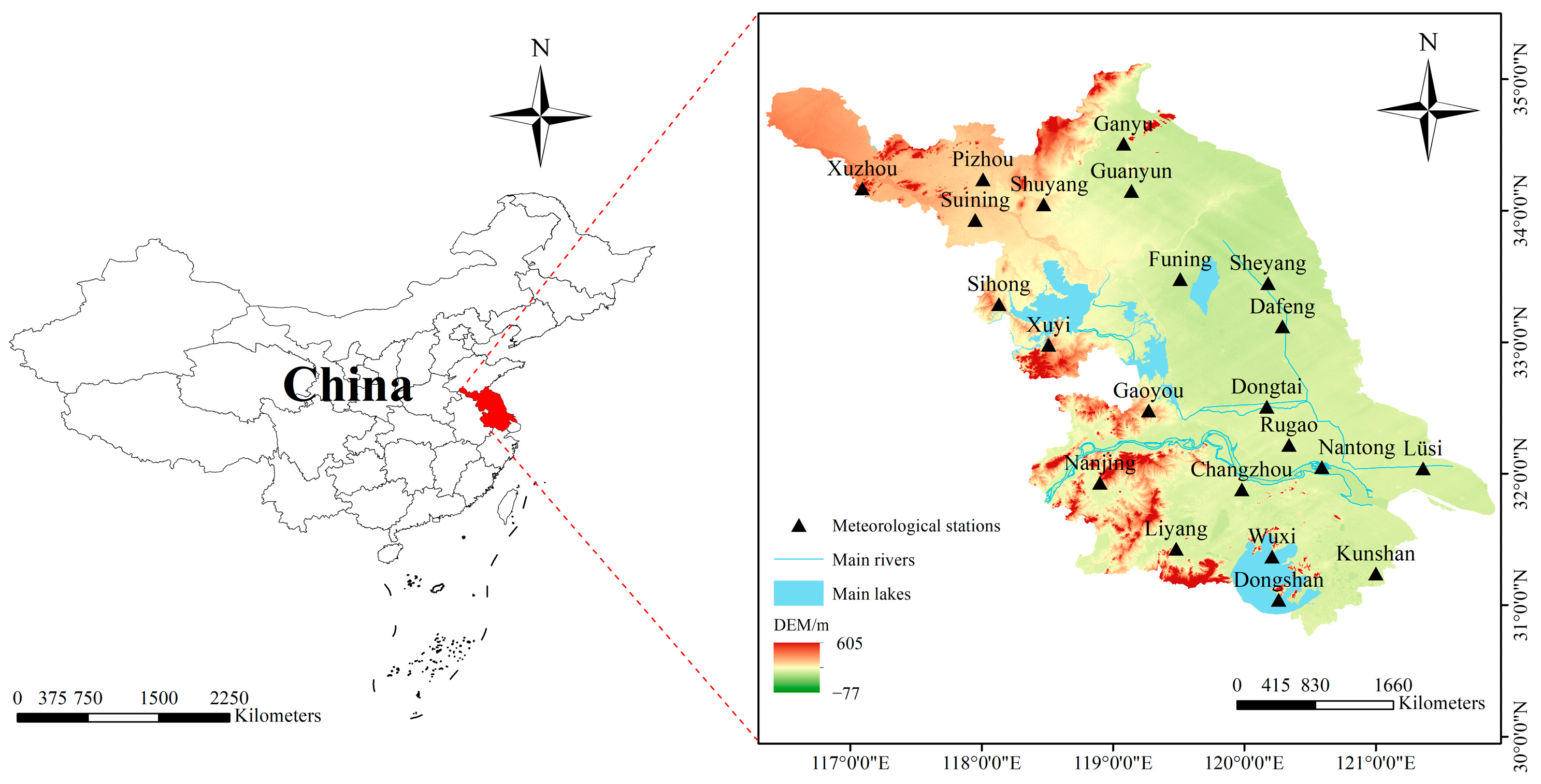
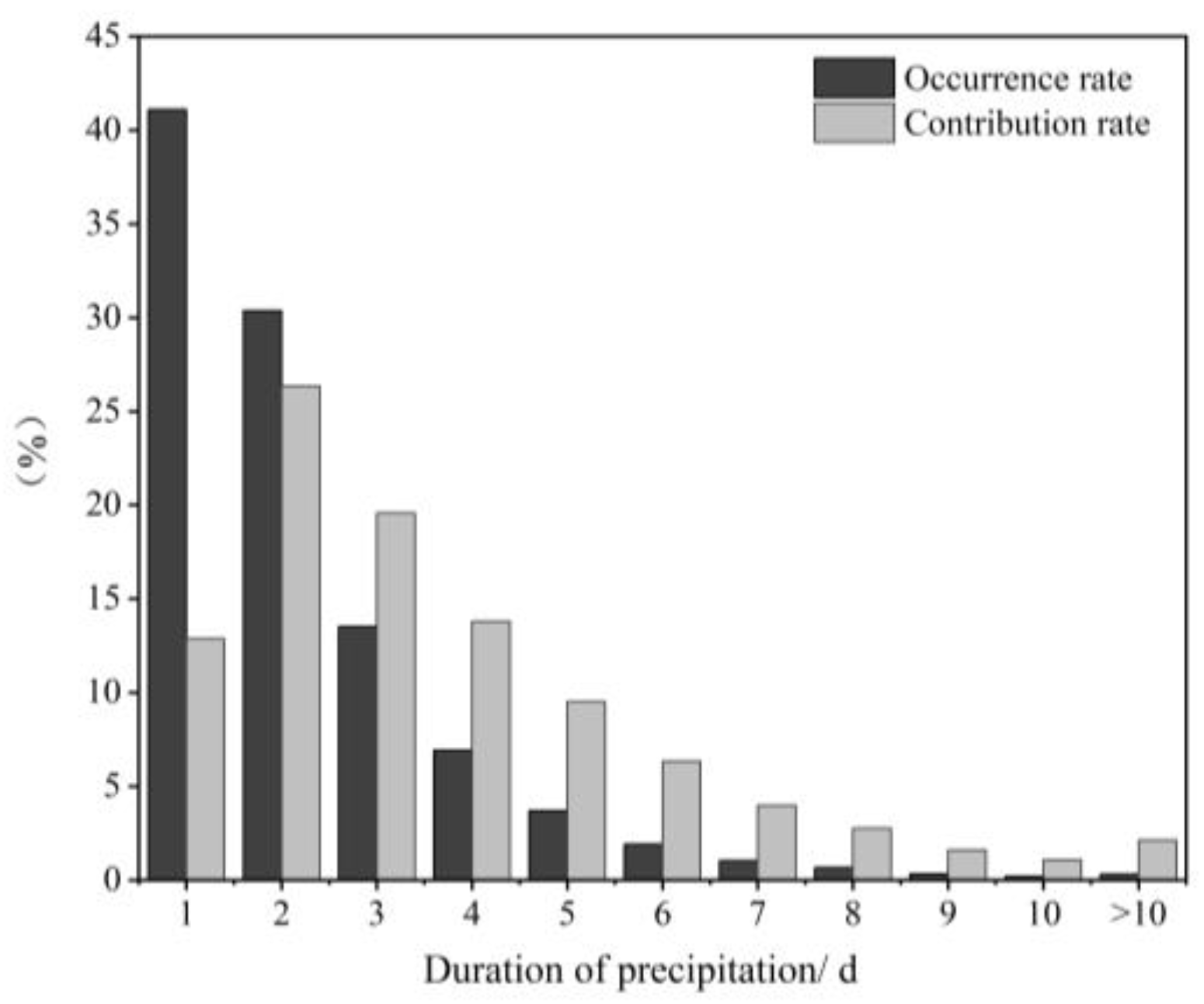
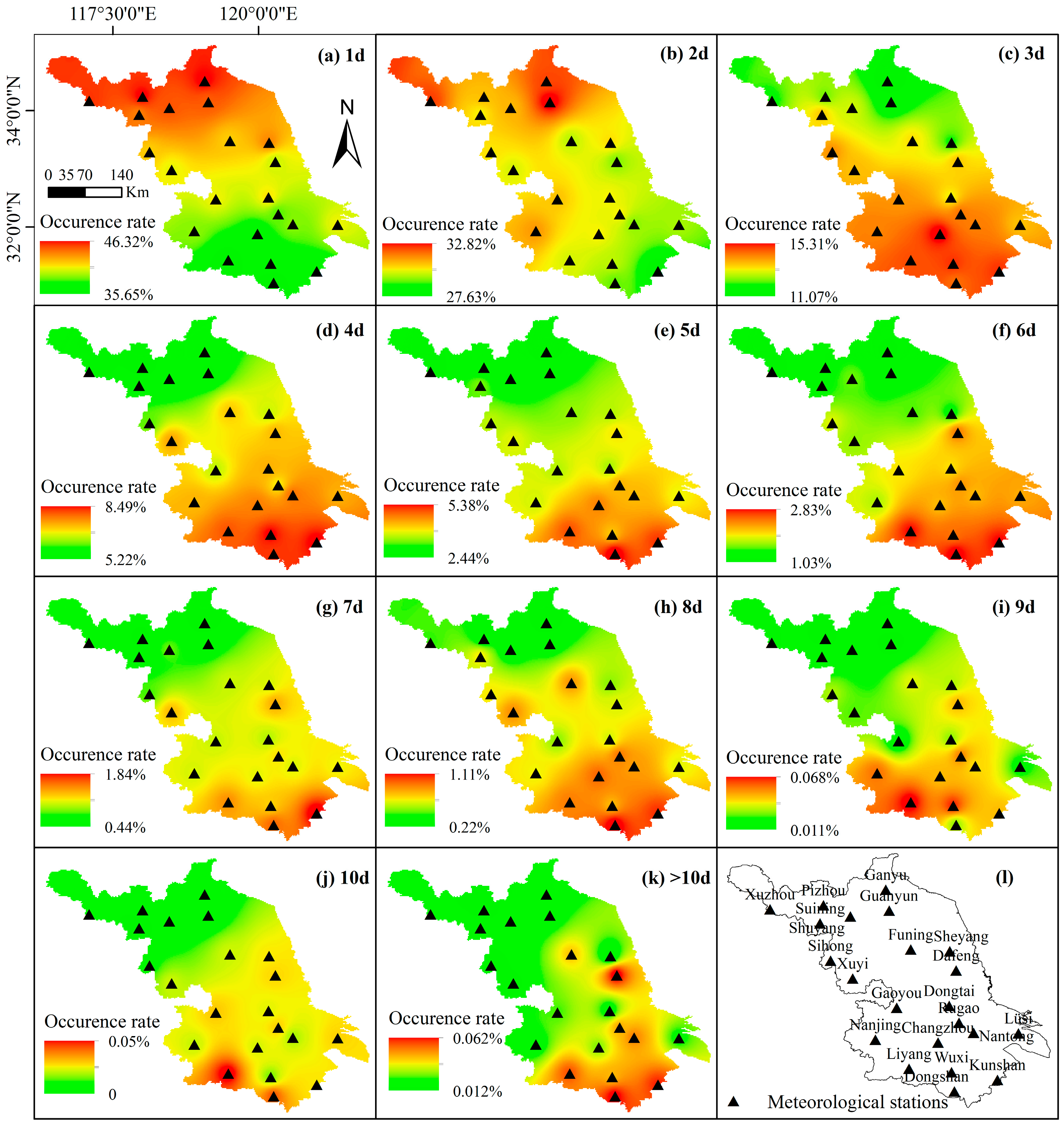
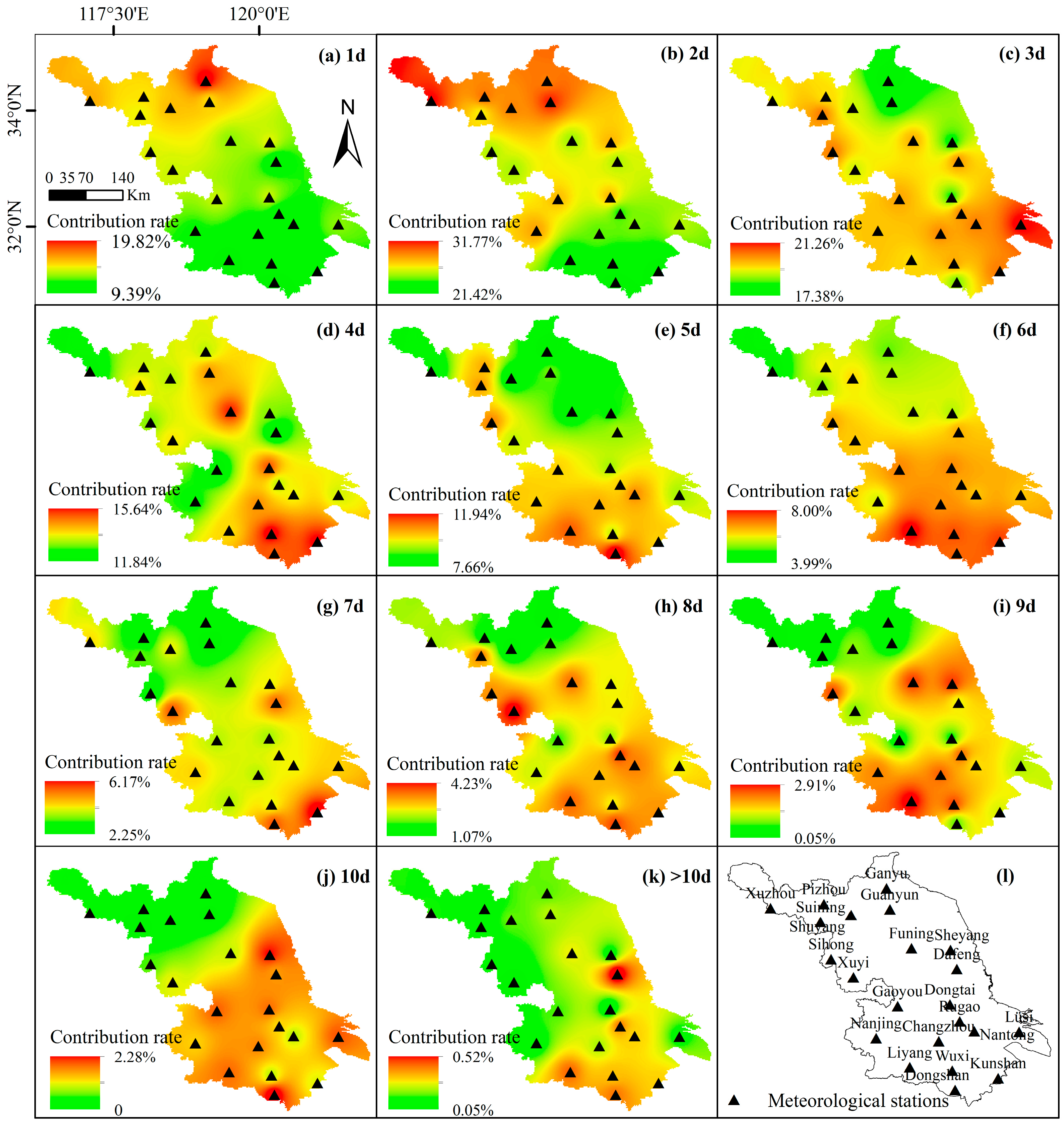
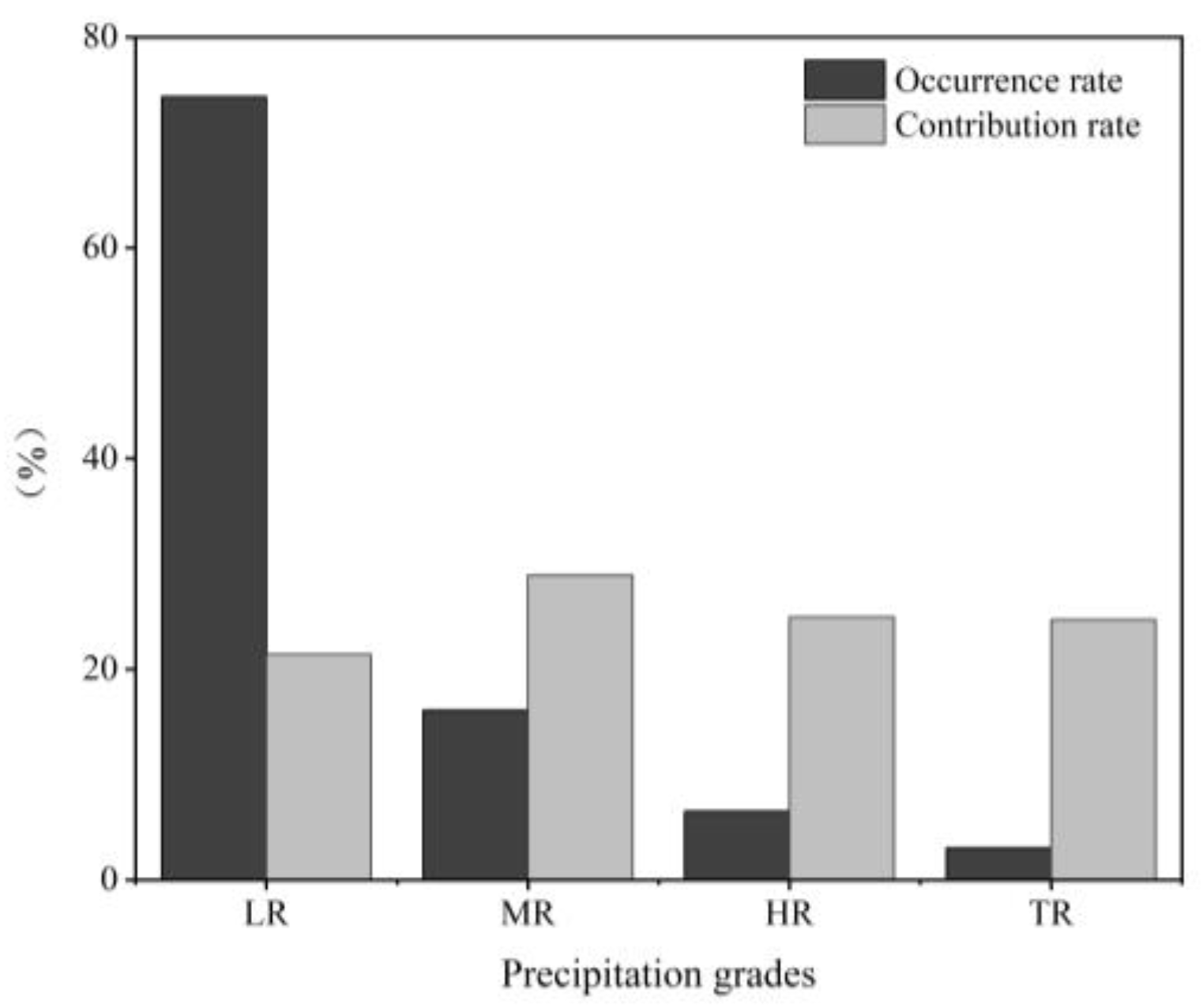
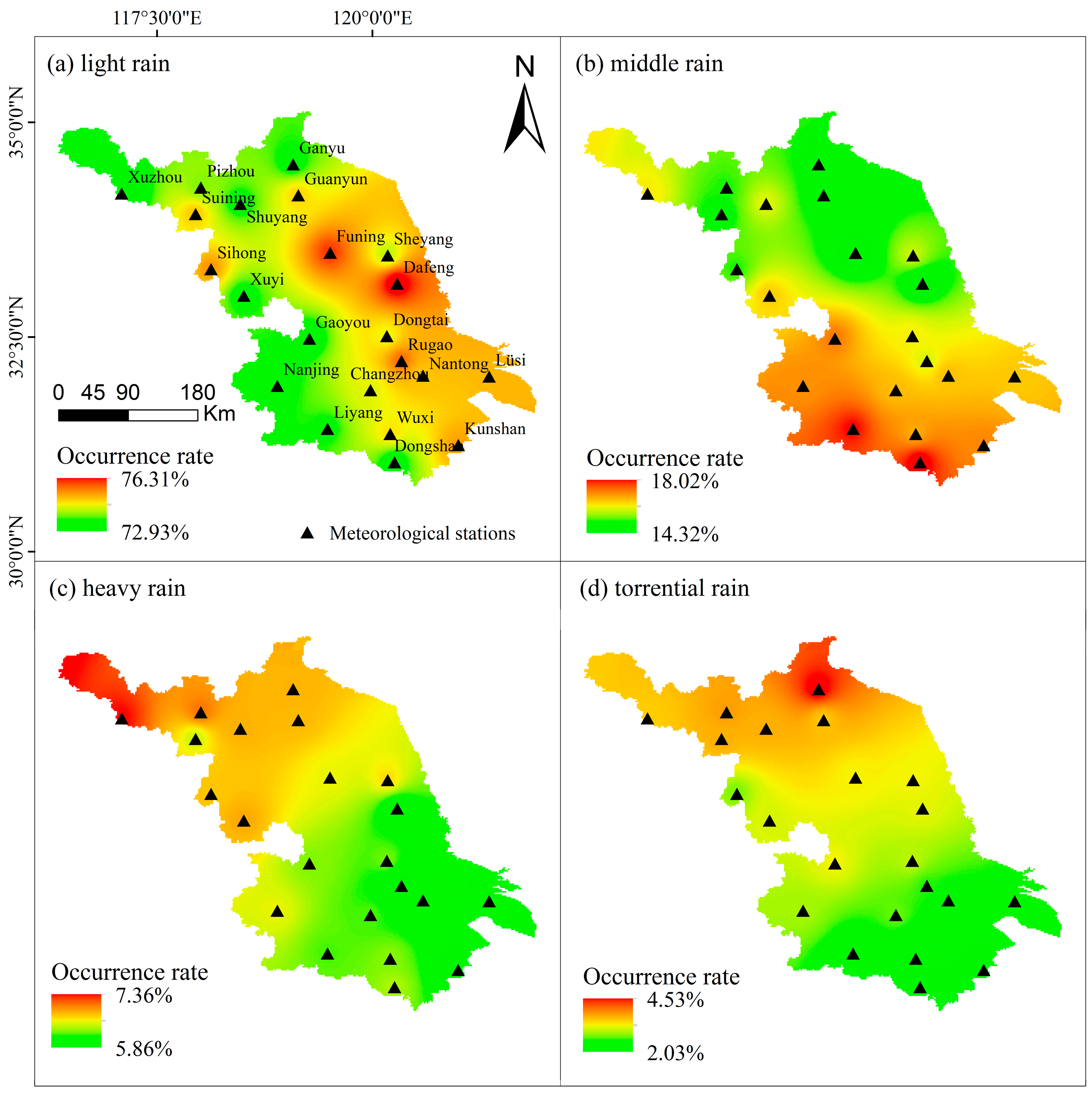
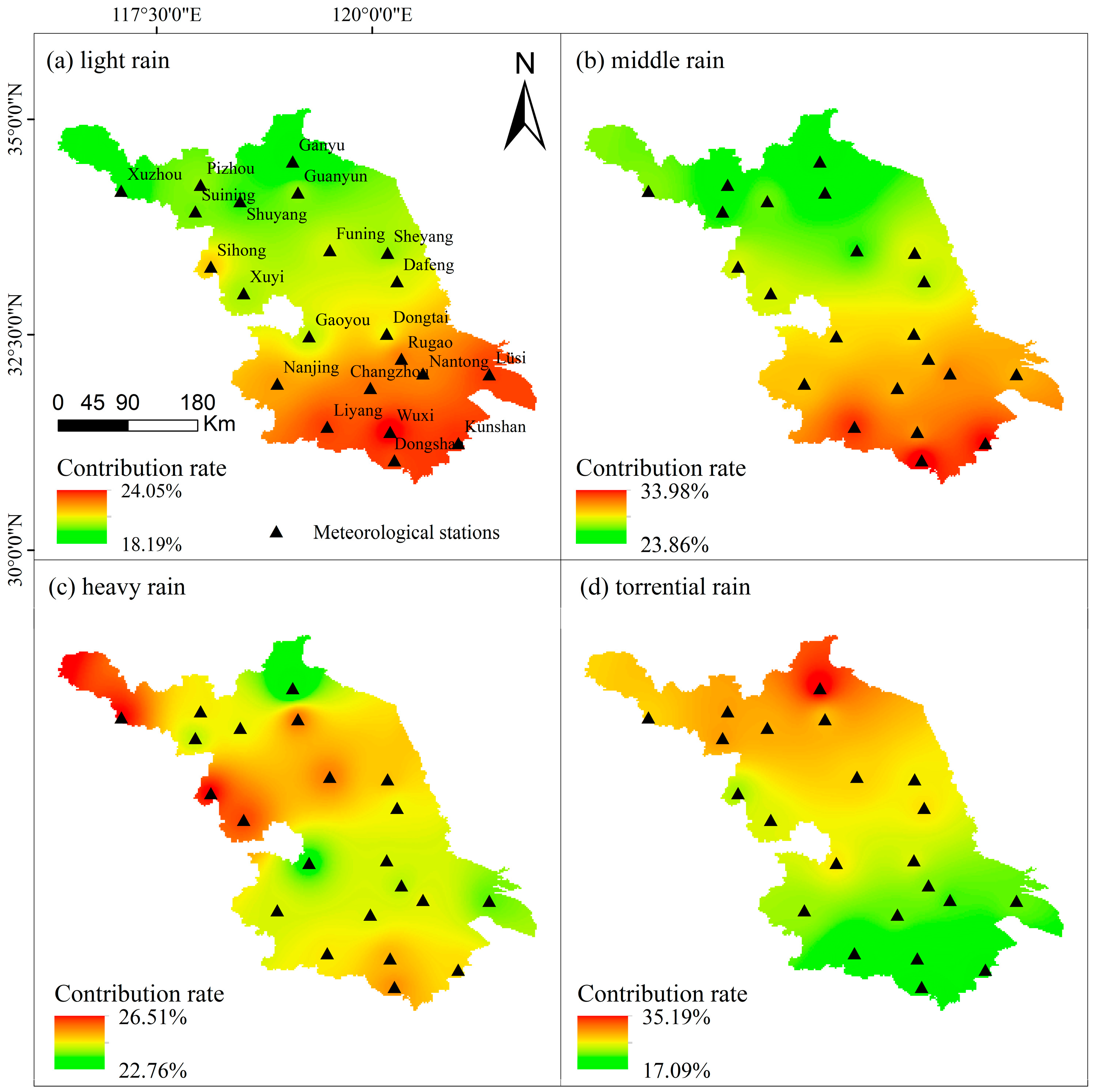
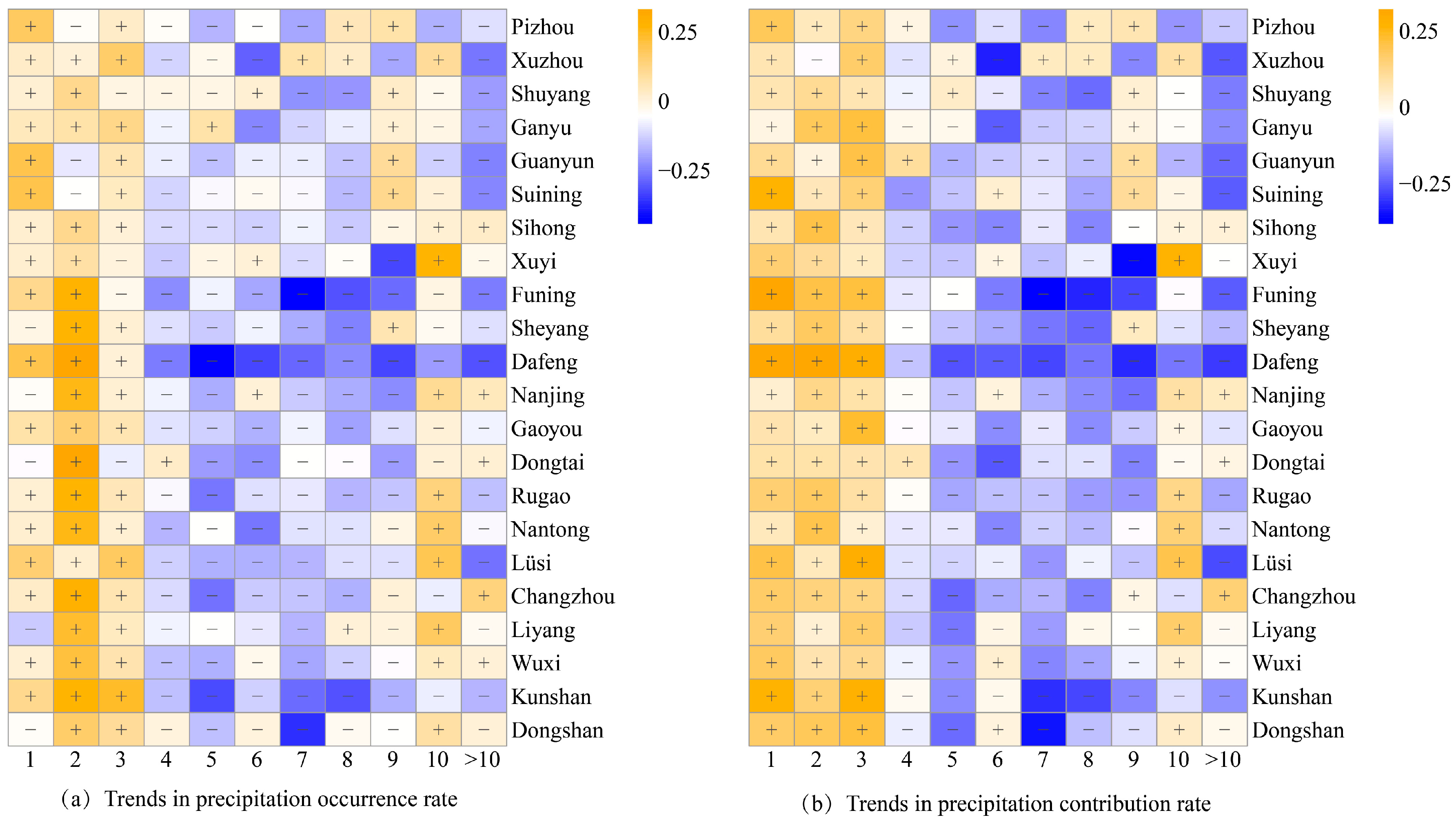
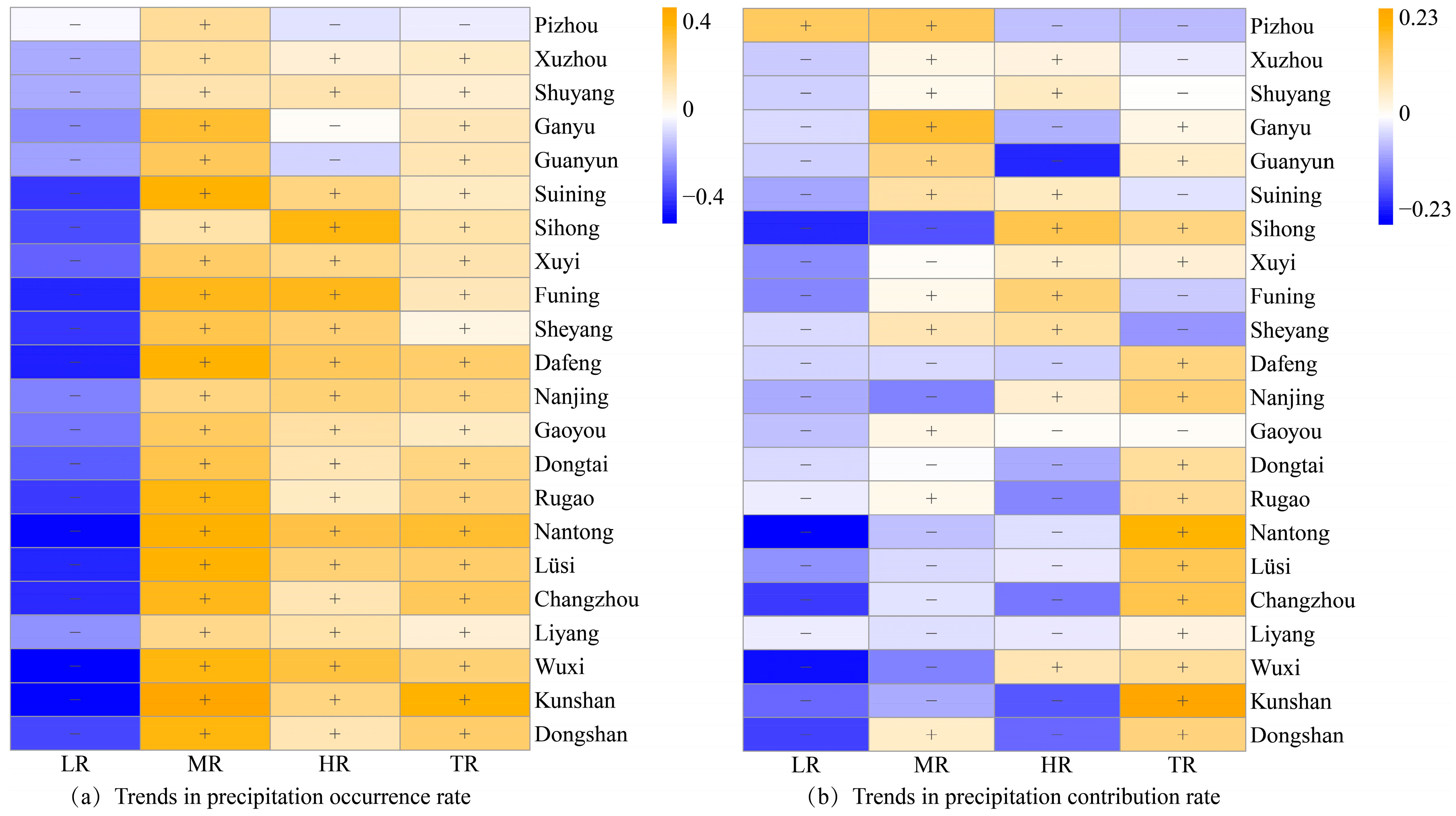
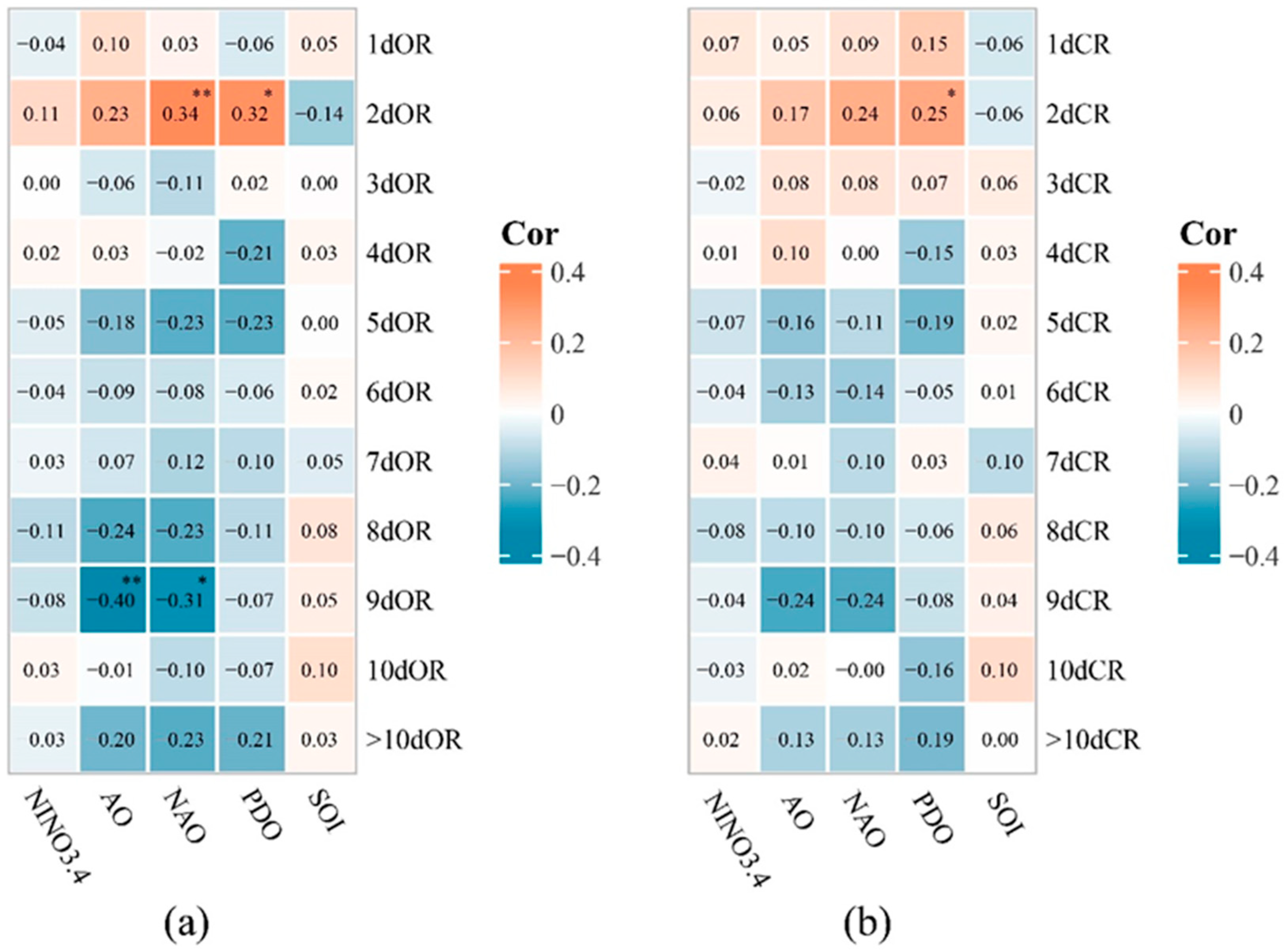
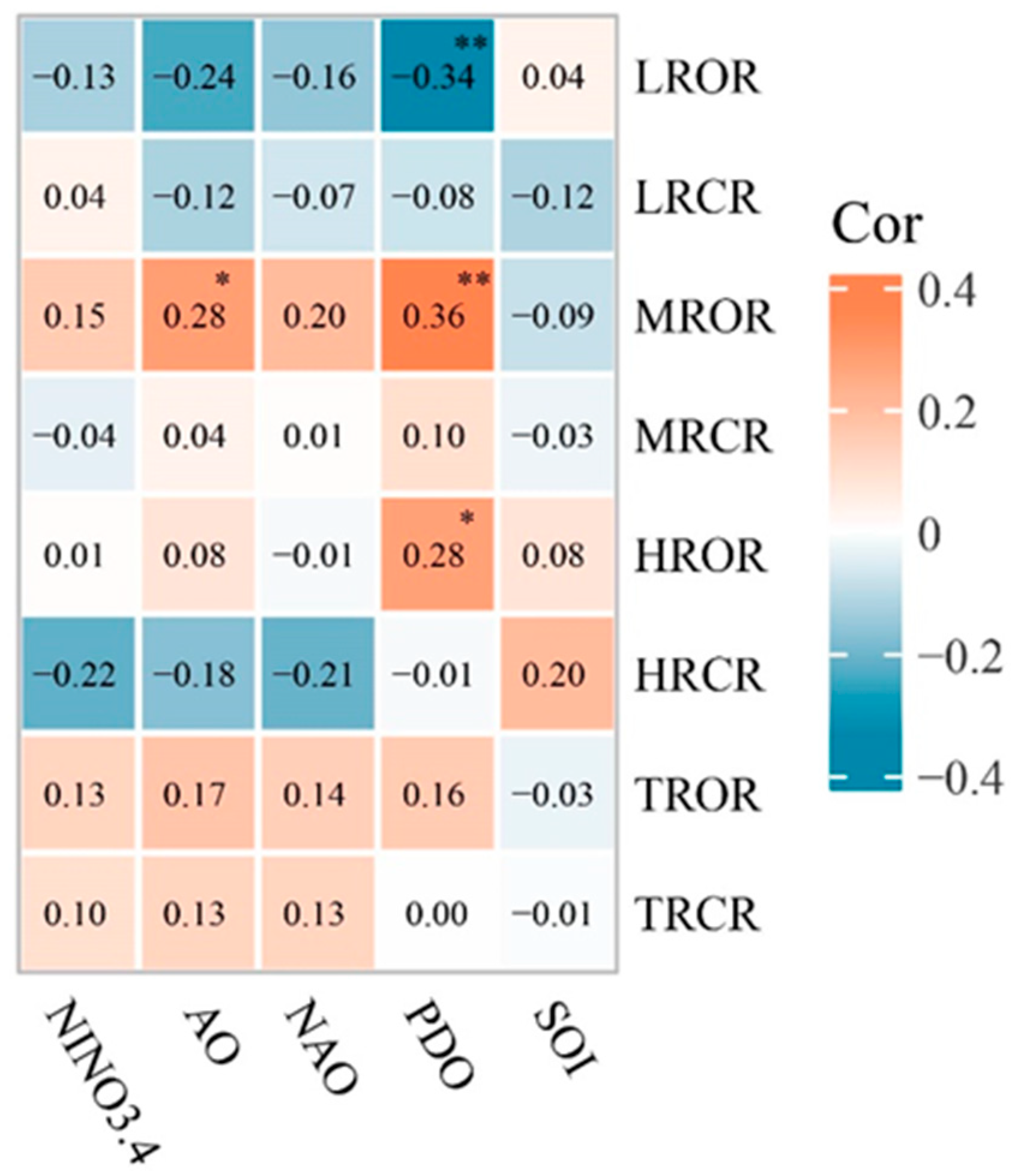
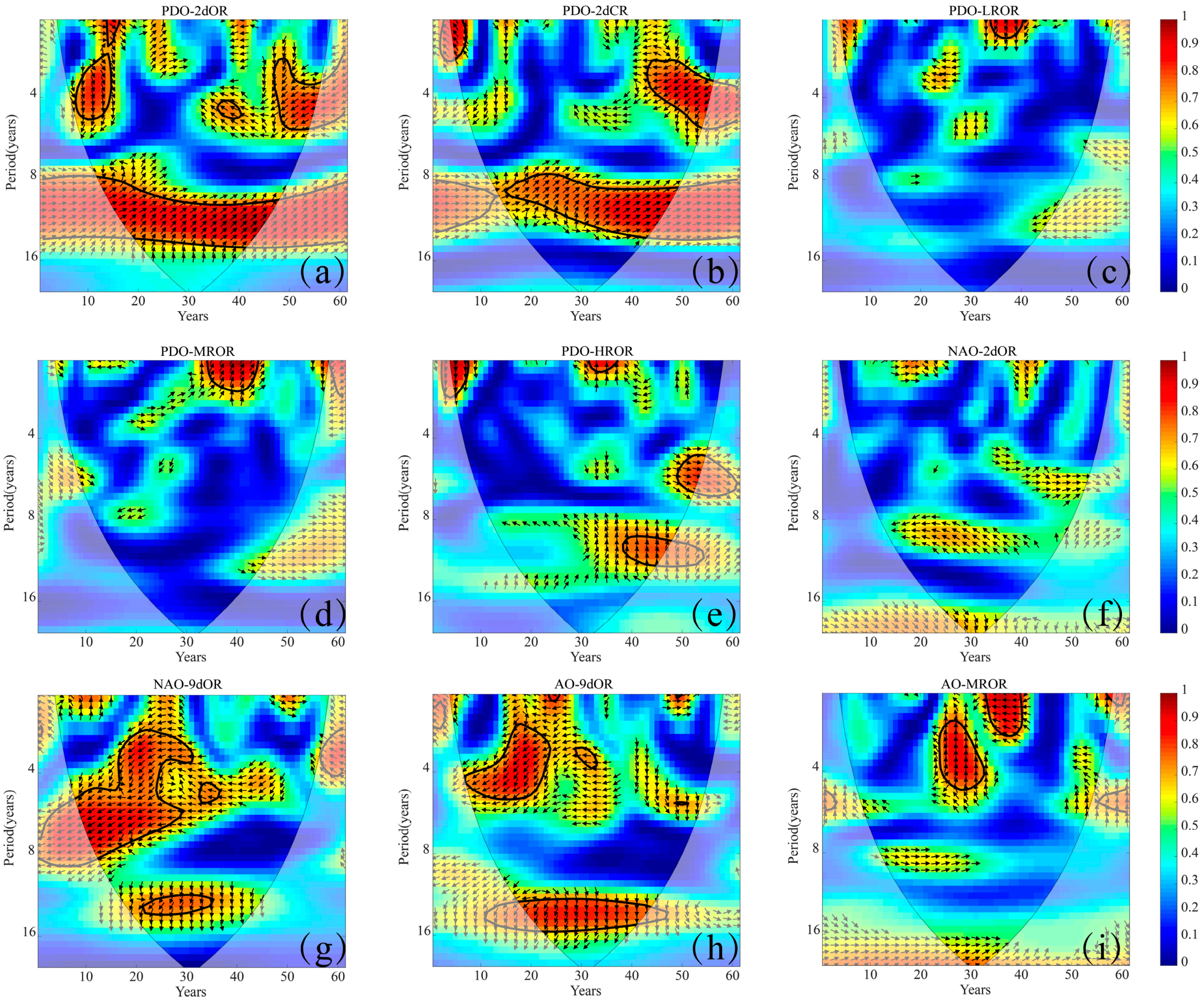
| Station ID | Station Name | Lon/E | Lat/N | Elevation/m | Duration |
|---|---|---|---|---|---|
| 58026 | Pizhou | 118.01 | 34.24 | 25.5 | 1960–2020 |
| 58027 | Xuzhou | 117.09 | 34.17 | 41.2 | 1960–2020 |
| 58038 | Shuyang | 118.47 | 34.05 | 10.4 | 1960–2020 |
| 58040 | Ganyu | 119.08 | 34.51 | 5.3 | 1960–2020 |
| 58047 | Guanyun | 119.14 | 34.15 | 4.8 | 1960–2020 |
| 58130 | Suining | 117.95 | 33.93 | 23.8 | 1960–2020 |
| 58135 | Sihong | 118.13 | 33.29 | 16.9 | 1960–2020 |
| 58138 | Xuyi | 118.51 | 32.98 | 40.8 | 1960–2020 |
| 58143 | Funing | 119.51 | 33.48 | 4.8 | 1960–2020 |
| 58150 | Sheyang | 120.18 | 33.45 | 2 | 1960–2020 |
| 58158 | Dafeng | 120.29 | 33.12 | 3.1 | 1960–2020 |
| 58238 | Nanjing | 118.9 | 31.93 | 35.2 | 1960–2020 |
| 58241 | Gaoyou | 119.27 | 32.48 | 5.4 | 1960–2020 |
| 58251 | Dongtai | 120.17 | 32.51 | 3.3 | 1960–2020 |
| 58255 | Rugao | 120.34 | 32.22 | 6.4 | 1960–2020 |
| 58259 | Nantong | 120.59 | 32.05 | 4.8 | 1960–2020 |
| 58265 | Lüsi | 121.36 | 32.04 | 3.6 | 1960–2020 |
| 58343 | Changzhou | 119.98 | 31.88 | 4.4 | 1960–2017 |
| 58345 | Liyang | 119.48 | 31.43 | 5.9 | 1960–2020 |
| 58354 | Wuxi | 120.21 | 31.37 | 3.2 | 1960–2020 |
| 58356 | Kunshan | 121 | 31.24 | 3.2 | 1960–2020 |
| 58358 | Dongshan | 120.26 | 31.04 | 16.7 | 1960–2020 |
Disclaimer/Publisher’s Note: The statements, opinions and data contained in all publications are solely those of the individual author(s) and contributor(s) and not of MDPI and/or the editor(s). MDPI and/or the editor(s) disclaim responsibility for any injury to people or property resulting from any ideas, methods, instructions or products referred to in the content. |
© 2023 by the authors. Licensee MDPI, Basel, Switzerland. This article is an open access article distributed under the terms and conditions of the Creative Commons Attribution (CC BY) license (https://creativecommons.org/licenses/by/4.0/).
Share and Cite
Ren, Z.; Zhao, H.; Shi, K.; Yang, G. Spatial and Temporal Variations of the Precipitation Structure in Jiangsu Province from 1960 to 2020 and Its Potential Climate-Driving Factors. Water 2023, 15, 4032. https://doi.org/10.3390/w15234032
Ren Z, Zhao H, Shi K, Yang G. Spatial and Temporal Variations of the Precipitation Structure in Jiangsu Province from 1960 to 2020 and Its Potential Climate-Driving Factors. Water. 2023; 15(23):4032. https://doi.org/10.3390/w15234032
Chicago/Turabian StyleRen, Zikang, Huarong Zhao, Kangming Shi, and Guoliang Yang. 2023. "Spatial and Temporal Variations of the Precipitation Structure in Jiangsu Province from 1960 to 2020 and Its Potential Climate-Driving Factors" Water 15, no. 23: 4032. https://doi.org/10.3390/w15234032
APA StyleRen, Z., Zhao, H., Shi, K., & Yang, G. (2023). Spatial and Temporal Variations of the Precipitation Structure in Jiangsu Province from 1960 to 2020 and Its Potential Climate-Driving Factors. Water, 15(23), 4032. https://doi.org/10.3390/w15234032






